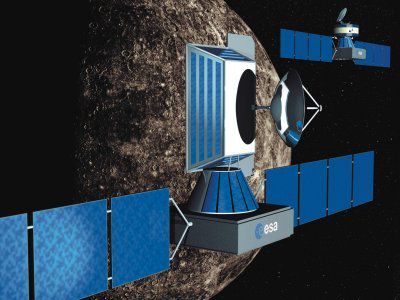-
 Barebone computer
Barebone computer
-
 Welding
Welding
-
 Pipeline
Pipeline
-
 Anthrax
Anthrax
-
 MD4
MD4
-
 Calamus
Calamus
-
 Nucleic acid
Nucleic acid
-
 MHC
MHC
-
 Southern right whale
Southern right whale
-
 Office automation
Office automation
-
 Man-in-the-middle attack
Man-in-the-middle attack
-
 Neoproterozoic
Neoproterozoic
-
 Bacillary
Bacillary
-
 Browser hijackers
Browser hijackers
-
 Ebola virus haemorrhagic fever
Ebola virus haemorrhagic fever
-
 Metamaterials
Metamaterials
-
 Spokes
Spokes
-
 Mucolytic
Mucolytic
-
 Iron
Iron
-
 FPGA
FPGA
-
 Pentose
Pentose
-
 Drone
Drone
-
 RSS
RSS
-
 Heliocentric
Heliocentric
-
 Aspergillosis
Aspergillosis
-
 Allosteric site
Allosteric site
-
 Reduced substance
Reduced substance
-
 Remote data processing
Remote data processing
-
 Acupressure
Acupressure
-
 Monoclinic system
Monoclinic system
Bepi Colombo
Bepi Colombo is an ESA mission in cooperation with Japan. It has two probes: the first (Mercury Planetary Orbiter) will analyse the surface and interior of Mercury, while the second probe (Mercury Magnetospheric Orbiter) will analyse the magnetosphere and the planet's magnetic field.
On arriving close to Mercury, Bepi Colombo will have to withstand temperatures up to 250°C, a challenge given that normally, space missions take place in very cold environments. Bepi Colombo will use electric propulsion, a technological process already tested by Smart-1 and extremely interesting from a cost and performance point of view.
Operation
Models of Bepi Colombo are currently undergoing shock and vibration tests. Launch is planned in 2015. After a journey of over 4 years, it will arrive near Mercury and send images and data back to Earth.
Scientific questions
Mercury is the least visited planet in the solar system (after Pluto). It is too close to the Sun for observations from Earth, and many questions about it remain unanswered. What can we learn about the formation of the solar system and telluric planets? Why has Mercury such a high density? Is Mercury's core solid or liquid? Why does such a small planet have a magnetic field whereas Venus, Mars and The Moon have none? Why do spectroscopic observations not show iron to be present, when it is assumed to be the main constituent of Mercury? Do craters permanently in the shade really contain water?
The Bepi Colombo mission is one of the ESA's most ambitious, and it will attempt to answer these questions within the next fifteen years or so.
 Bepi Colombo mission to Mercury
Bepi Colombo mission to Mercury
Latest
Fill out my online form.



